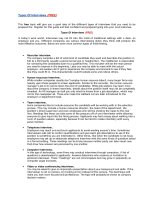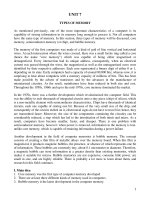types of literature
Bạn đang xem bản rút gọn của tài liệu. Xem và tải ngay bản đầy đủ của tài liệu tại đây (1.04 MB, 54 trang )
Types of Literature
Genre – the type of
literature, such as a
novel or a short story
Fiction
–
works of
prose that
have
imaginary
elements
Prose
Nonfiction
writing
that deals
with real
people,
events, and
places.
Short Story
can usually be read in
one sitting.
Generally, a short
story has one main
conflict that involves
the characters, keeps
the story moving,
and makes it
interesting
Poetry
Type
of literature in which
words are chosen and
arranged to create a
certain effect.
Novel
A long work that
tells a complex
story that unfolds
through the
actions, speech,
and thoughts of
the characters.
Drama
Literature in
which plot and
characters are
developed
through
dialogue and
action; in other
words, drama is
literature in play
form.
Epic
A long narrative poem
about the adventures of a
hero whose actions reflect
the ideals and values of a
nation or race.
A
Memoir
form of
autobiographical
writing in which a
person recalls
significant events
in his or her life
Narrative Nonfiction
Nonfiction is writing that tells about real
people, places, or events.
The information in narrative nonfiction is
organized in chronological order.
Three types of narrative nonfiction are
biography, autobiography, and certain
kinds of essays.
AUTOBIOGRAPHY
The writer’s account of
his or her own life.
Almost always told
from the first person
point-of-view, it
generally focuses on
significant events and
how those events and
people affected him or
her.
BIOGRAPHY
An account of a person’s life
written by another person.
The writer usually reaches his or
her subject to present accurate
information, and ideally strives
for a balances treatment,
highlighting weaknesses as well
as strengths, failures as well as
achievements.
ESSAY
A brief work of nonfiction that
deals with a single subject.
In a formal essay, ideas are
developed systematically and
impersonally.
An informal essay, which is less
rigidly organized and more
personal, often includes humor
and anecdotes.
There are three common types of
essays:
EXPOSITORY - essays present or
explain information and ideas.
PERSUASIVE - essays present
arguments and attempt to convince
readers to adopt particular points of
view.
PERSONAL - essays express
writers’ thoughts and feelings about
subjects.
Elements of Storytelling
Fiction,
narrative nonfiction,
poetry, or drama includes
some or all of the following
elements of storytelling:
PLOT
The
sequence of events in
a story.
CONFLICT
A
struggle between
opposing forces.
The struggle may exist
between people, between
people and nature or
society, or within a
character.
The
CHARACTERS
people,
animals, or
imaginary
creatures
that take
part in the
action.
SETTING
The
particular
time and
place in
which the
events
occur.
THEME
Perception
about life or
human nature that the
writer conveys to the reader.
It is also known as the
lesson learned throughout
the story by the character(s)
or even the reader.
POINT OF VIEW
Refers
to
the vantage
point from
which the
story is
told.
DIALOGUE
The
written
conversation
between two
or more
characters.
SUSPENSE
The excitement
or tension that
readers feel as
they get
involved in the
story and
become eager to
know the
outcome.
FORESHADOWING
A writer’s use
of hints or
clues to
indicate
events that
will occur later
in the
narrative.









